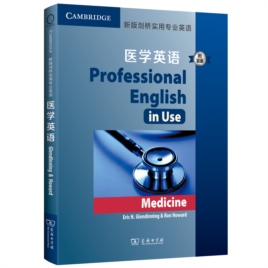显示全部编辑推荐
丛书简介:
“新版剑桥实用专业英语系列”是从剑桥大学出版社引进的一套英文影印书,共6本,分别是《医学英语》《法律英语》《工程英语》《市场营销英语》《管理英语》和《金融财务英语》。

定价:¥68.00
丛书简介:
“新版剑桥实用专业英语系列”是从剑桥大学出版社引进的一套英文影印书,共6本,分别是《医学英语》《法律英语》《工程英语》《市场营销英语》《管理英语》和《金融财务英语》。
《新版剑桥实用专业英语:医学英语(附答案)》是为学习医学且具有中高级英文水平的学习者设计的,它提供的医学专业英语,有助于提高学习者对医学期刊、书籍的阅读水平,帮助医学工作者或学生参加医学国际会议,或到讲英语的国家进行短期海外实习。此书可作为自学的学习资料,也可以作为课堂教学的课本,既可一对一来学习,还可以学习小组的形式来学习。
Mintzberg
Henry Mintzberg, a Canadian professor of management, has made significant contributions to our understanding of managerial work and the role of the manager. He has identified different roles in a manager’s job and placed them in three categories:
Interpersonal roles – a manager is the figurehead, providing leadership for the team, the department or the organization and liaising with other stakeholders (both internal and external)
Information roles – a manager has to be an effective communicator as information constantly moves in, round and out of the organization
Decision roles – a manager has responsibility for spotting opportunities, allocating resources and dealing with conflict or the day-to-day differences that can arise in any team or organization.
Management practice
Pavel is speaking to some new recruits at a major firm of management consultants, where he is to be their mentor during the first six months:
‘Welcome to Delboi! I have three pieces of advice as you make the move from studying management to the real-world environment in which we work:
First: you need to be a team player. Our success here comes from collaborating with colleagues to create feasible solutions when we are interacting with clients.
Second: all the solutions that you recommend to our clients have to be practical rather than academic. You have to integrate what you have been learning and constantly challenge your own assumptions. You need to be able to develop creative thinking skills and discuss complex issues in the workplace from a ‘people perspective’.
And finally: if you do not know something, or if you are uncertain about how we do things
here, please ask!
‘We hope you enjoy your time here and we look forward to working with you.’
京ICP备05007371号|京ICP证150832号|![]() 京公网安备 11010102001884号 版权所有 2004 商务印书馆
京公网安备 11010102001884号 版权所有 2004 商务印书馆
地址: 北京王府井大街36号|邮编:100710|E-mail: bainianziyuan@cp.com.cn
产品隐私权声明 本公司法律顾问: 大成律师事务所曾波律师